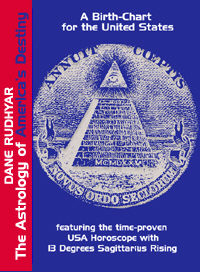 |
| Home | Bio | Art | Music | Literature | Civilization & Culture | Philosophy of Wholeness | Theosophy & Spirituality | Astrology |

THE ASTROLOGY
OF AMERICA'S DESTINY A Birth-Chart for the USA by Dane Rudhyar, 1974 THE ASTROLOGY OF AMERICA'S DESTINY Table of Contents
1. The Birth of the United States
as a Collective Person 2.The Roots of the American Nation Page 1 Page 2 Page 3 Page 4 Page 5 Page 6 Page 7 Page 8 Page 9 Page 10 3. America's Place in the Cosmic Process 4. A Birth Chart for the United States of America 5. Two Hundred Years of Growth Through Crisis 6. A Chart for the Beginning of the Federal Government 7. America at the Crossroads 8. Prospects for the Last Quarter Century Illustrations • George Washington receiving the horoscope of America from the Angel Gabriel • The Reverse Side of the Great Seal of the United States • A Chart for the United States of America • A Chart for the Beginning of the Federal Government • A Chart for Richard M. Nixon • A Chart for the Twentieth Century |

CHAPTER TWO:
The Roots of the American Nation - 10 The practical realities and expediencies of life, especially in a newborn nation, had evidently to be considered, and the stand taken by Hamilton and Washington had value; but developments that occur in infancy do persist in later years, and once a definite quality of social and national living becomes habitual, it becomes extremely difficult to alter it, except perhaps through violent crises which often solve nothing fundamental. The question that should be asked by anyone accepting a purposive approach to history and human evolution is: To what extent has this collective person, the United States of America, fulfilled its destiny as a new and powerful agent within the cycle of Western civilization? The answer to this question, I believe, rests upon a grasp of what the Industrial Revolution and our more recent Electronic Revolution have meant. Undoubtedly the development by Western man of new intellectual, faculties made available a tremendous amount of power. But when power is made available, another question immediately arises: To what use will it be put? In a very real sense the answer was already foreshadowed in the first cargo of Negro slaves that reached Virginia. It was further implied in the refusal by delegates of Southern states to accept the provision against slavery that Jefferson had included in the original draft of the Declaration of Independence. It was reasserted when Benjamin Franklin's example of friendship to the Indians was negated by nineteenth-century men intent upon the development of a big powerful nation dominated by an individualistic yearning for power and wealth and utterly conditioned by dogmatic ideas concerning the absolute value of their religion and culture. It is true that in the past the building and growth of a nation or empire have never proceeded humanely, but America was to be "the New World" and not merely a new nation. Two basic conceptions of America have always been in conflict: the great new ideal of world Americanism which Walt Whitman extolled, saying: "O America, because you work for the world, I work for you" — and that of a nationalistic United States. Many people will say that the United States had to be and now more than ever must be a strong united nation to offset the drive for power of other nations embodying social systems opposite to what I have described as the great and so often frustrated ideal of our Western civilization. But how can we effectively fight for principles and values which we uphold in beautiful phrases while in so many ways betraying them in actions and in a general quality of living and behaving? What we are facing today in America is not merely a political crisis, but a crisis in collective consciousness. We have to reassess the fundamental meaning of what our Western civilization has brought to mankind and what the meaning and destiny of America essentially are now. We have to try, first of all, to clearly understand, the present world, which we have been largely responsible for transforming through our industrial and managerial skills, and the example of which we eagerly export. Talleyrand once said that politics is the art of the possible; but so is civilization. What is possible today? Economic or political theories are not inclusive enough to provide a truly satisfying answer. An individual of course has his intuition, or whatever is back of his consciousness as a guiding power, to show him the way. But when we deal with vast collective and global issues, the real answer lies in the universe itself and in its majestic rhythms that, no man or nation can deviate or alter. We can ask of the universe that surrounds us: What time is it for mankind according to the clock of planetary destiny? What time is it for America? A brief study of some of the larger cycles which define this global "time" should give us a background for a more detailed analysis and interpretation By permission of Leyla Rudhyar Hill Copyright © 1974 by Dane Rudhyar and Copyright © 2001 by Leyla Rudhyar Hill All Rights Reserved.  Web design and all data, text and graphics appearing on this site are protected by US and International Copyright and are not to be reproduced, distributed, circulated, offered for sale, or given away, in any form, by any means, electronic or conventional. See Notices for full copyright statement and conditions of use. Web design copyright © 2000-2004 by Michael R. Meyer. All Rights Reserved. |
 |